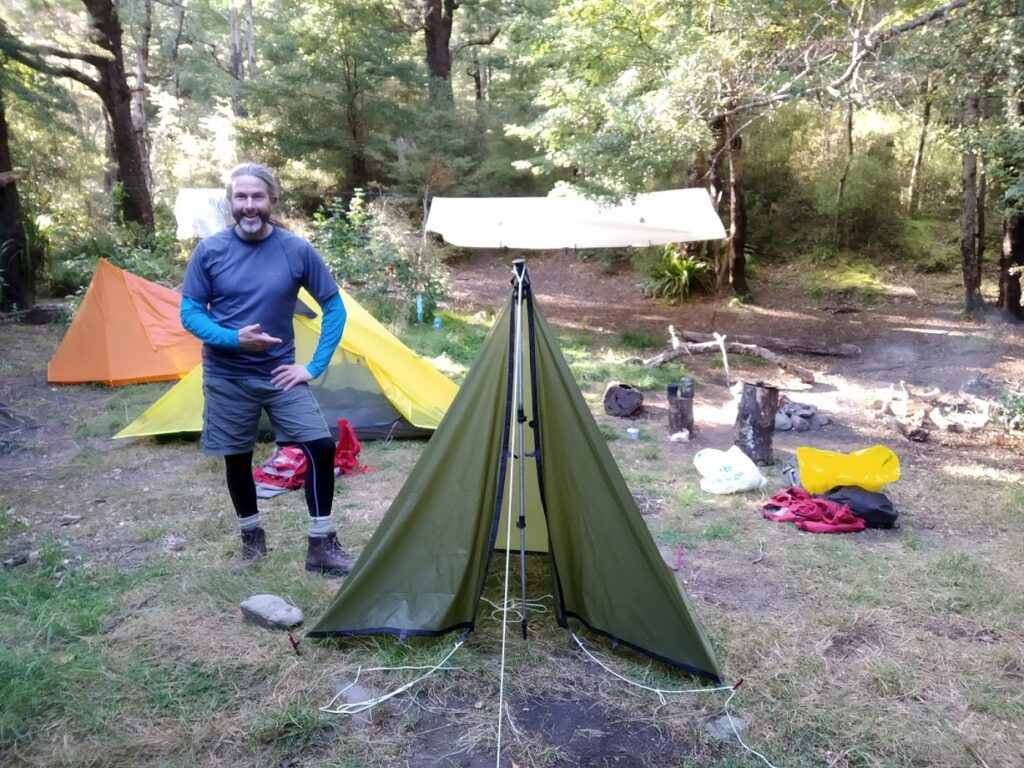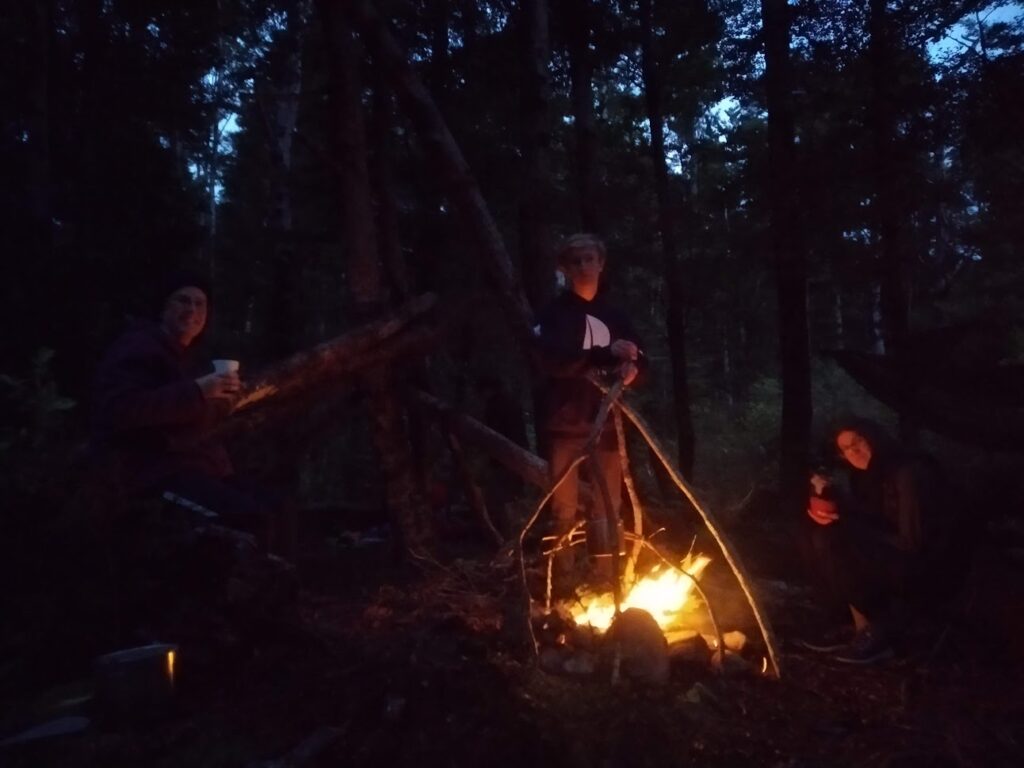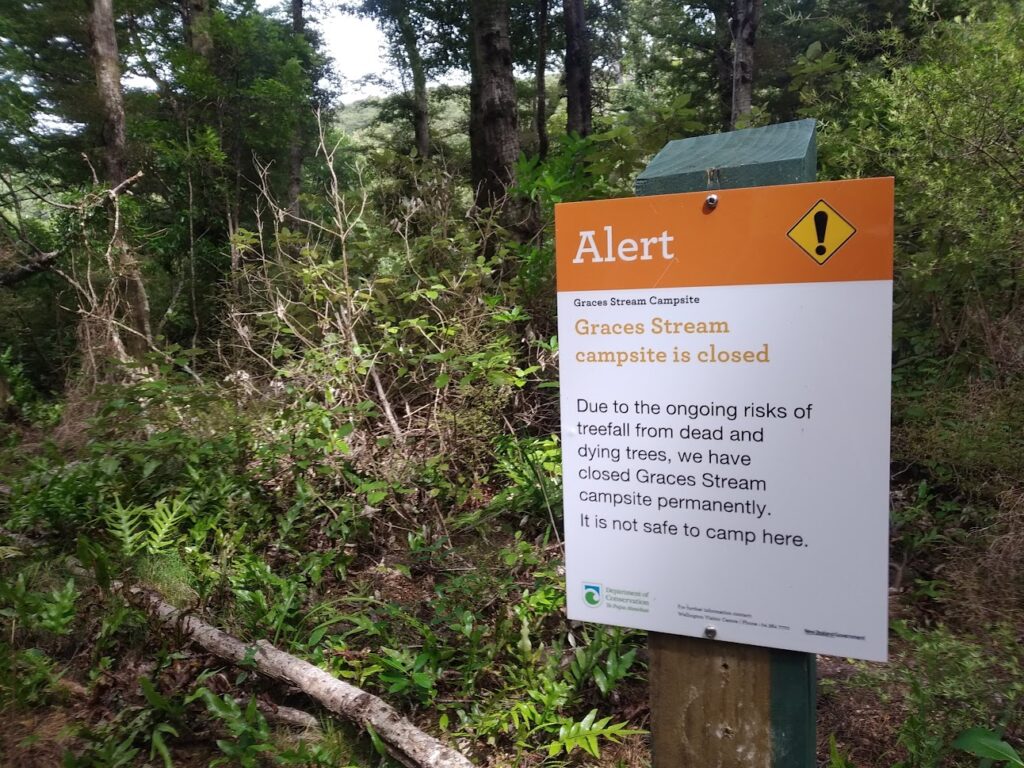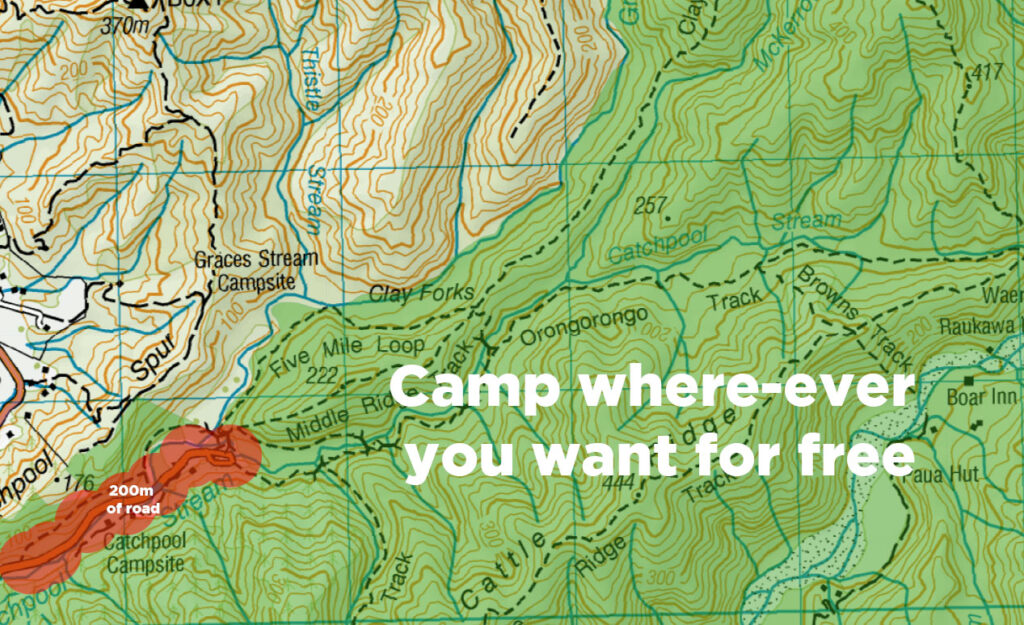There’s a hidden gem of a camping spot in the Wellington region. It’s ‘wild bush camping’, but safe, easy and accessible. With no set sites or vehicle access, it’s a proper adventure as you pick your camp among the trees and collect water from the stream. Your nervous mates can test their mettle and gear safely here, with the long-drop toilet and the security that if it all turns to crap, the car is just a fifteen minute walk away. This is particularly useful for the solo adventurer with no experienced friends; they can discover the site themselves on the camping locations websites.
This unique gem is Graces Stream Campsite. But DOC have just closed it. I am livid about it. It is just a simple little campsite, but as you’ll see it is so much more. And I feel it points to something larger within the operation of DOC that needs light shone on it, as they’re entrusted to manage our recreational assets on public conservation lands and they just don’t seem to care about this stuff. This’ll also serve as my tribute to Graces Stream campsite – gone but not forgotten.
Graces stream campsite
Graces Stream campsite sits in the first valley over from the Wainui Coast road. It’s an odd little spot, only 15 minutes in. It’s history is presumably as the site of this Log Cabin from old maps of the area. Before the Catchpool road was built in, access was all done over this hill (I think it was called the ‘gut buster track’).

My strongest earlier memory of the site is on the OTNZ Advanced Bushcraft training course in 2018. I was learning to be safe for my Te Araroa adventure. Our seasoned trainer based us there for our overnighter. From Graces Camp we ventured off-track through the forest, learning compasses and search and rescue techniques. We scurried about putting survival shelters together and learning to make a fire under the watchful ‘FIRES PROHIBITED’ sign. My first memories of Graces are as a place to learn bushcraft, a place to be introduced to our wild bush.
Since then I’ve camped there tonnes of times and it’s one of my favourite spots. It’s such an easily accessible but wild camp, a real easy place to enjoy getting back to nature. I won’t list every time, but here’s a selection of special memories for me:
- Going out there to camp and seeing a woman with her wee toddler, a digger toy and two dotting grandparents. They were going to camp out there, mother and son – with the grandparents keeping ‘home-base’ in their caravan at the catchpool campsite.
- The family out there, dad hammocked between trees in the mottled light, reading a story to his wee boy. It’s a picture etched into my mind, and one I hope to live for myself someday soon.
- Dave and I’s multiple, multiple adventures. Rain or shine, Dave and I have gone camping. Delighting in a small campfire we’ve spent many a night enjoying the peace of the bush. The mottled light filtering through beech, and the amber-tinted sap runoff from wet tentflies are particular joys.
- Trips with Claire and even our wee boy already.
- The gang affiliate/homeless guy camped out there for some months. Donned in a leather jacket, the dude smelt like he did not bathe in the steam. But he was pretty nice and friendly, and rode out on his bike each evening to enjoy the peace of the forest. ‘it’s nice to quietly enjoy sitting with the fire’ I remember him saying. I couldn’t agree more. I didn’t like that he’d moved onto a ‘temporary place’ in a more permanent fashion – I think that’s a dick move that spoils places for everyone long-term – but he just enjoyed the place too. I hope he’s found a bit of bush for his own.
- My sister Alex, my nephew T and Dave (bro) camped out there together, special family bonding times. I scored a flash tentpeg from then, which is a silly reminder of other’s enjoyment too.
- The impromptu Meetup trip I took with a days’ notice. ‘Hang in hammocks amongst the trees reading books’ I had suggested. This got two interesting attendees out for a night in the forest, something they both said they’d never have the stomach to do alone.
- Did you know MSC’s Get Outdoors series was filmed at Graces Campsite? (I strongly think anyway!)

A quiet loss of opportunity unrecognized
The closure has little effect on my brother and I. We continue to camp near the campsite, and frankly, somewhat enjoy the fact that no-one else does. Firewood is much easier to find.
However, it’s tinged with sadness now. Who will discover this place after us? That young mother with her toddler, that group of girlscouts – where will they camp now? ‘The vehicle access Catchpool campsite is a good local alternative’ I can hear DOC say – but anyone who’s spent a night in the actual bush can attest that it is NOT the same thing. Camping from the back of the car is like a hotel.
What gets me is the idea that new curious, aspiring and nervous campers will never discover, learn and grow their confidence at this wonderful spot. Like me with the OTNZ course, Graces Camp is burnt into my mind as one of the important nurturing starting places of my backcountry journey. It has had an important role in forming my self-identity and my identity as a New Zealander who grew up in the city but as an adult lives and loves our native environments.
DOCs argument
“The popularity of the site has been its downfall. People traffic and camping expanding outside of the core area has caused damage to the trees (predominantly beech) through compaction of the soil, which displaces air and water and damages roots.
This has led to increased risk of the trees falling, with unacceptable risks to visitors leading to the closure decision.”
DOC press release
“You loved it too much, so we’re closing it”.
This is, in essence, the problem. DOC’s dual pressures at play. Though it’s classic comms to blame the public for them not keeping their public facility open (their later reasoning is budgetary), it does expose the value system. The conservation is more important than recreation. Fair enough on DOC’s part; they aren’t the Department of Recreation after all.
How did DOC attempt to mitigate the impact of people? Did they explain to us the damage we made walking around? Did they rope off or cordon areas to allow untrampled growth patches? Did the threaten us with closure? Did they say they couldn’t afford to keep it open, and crowd source money? No, they tried nothing. They tried nothing.

Other closures
Around Wellington that I know of in my short time, here’s a few places that’ve been closed. I accept that slips are nobodies fault, however I don’t think they’d have stayed shut in the 60s. Each of these closures has weakened recreational access, weakened cultural connection opportunities for the people of New Zealand to be in our forests. Feel free to share in the comments a list of places DOC’ve opened to counter the impact of the closures – I look forward to reading it.
- Otaki forks (slip=closed)
- Waikawa campsite (budget=0; closed. Despite Otaki forks closed)
- Waikawa / Panatewaewae roadend (slip=roadend carpark closed)
- Graces stream campsite (closed)
The permanence of closure
Once these places are gone, they are mostly gone forever. The mythical ‘we’ll open it again when we have budget’ will never come of course. Mothballing is a way of stalling for time, stalling your passions. While places are mothballed they fall into disrepair and are vandalised. The cost to re-vitalise balloons and the community memories get more distant. The places stop being whatever and become a bit of conservation estate, and re-building a site requires running the full gamut of approvals and processes. It just won’t happen – closures are for good.
DOC don’t seem to try very hard to maintain recreational access
DOC never acknowledged our (or maybe just my) love of Graces Stream Campsite. Never considered the loss of community opportunity and cultural erosion in closing it. Never consulted, just did it. And that’s why I’ve written this. At the end of the day, while I am sure many staff do, the DOC organisation doesn’t prioritise this stuff. Their role is conservation – something I feel they do really well on the little they’re funded. Our tourism sector owes them everything. I have nothing but respect for the work DOC and their staff do on the conservation front.
But they’re also entrusted with the recreational connection for all of us to our public conservation lands, and their budget and priorities no longer put recreation on the page. Remember, it isn’t DOCs land to conserve – it’s all of ours. We say how we want to enjoy our public lands, not DOC. And it seems to me, under DOCs modern management and their priorities, places like Graces Stream campsite are being closed under budget pressures (levered via Health and Safety requirements that cannot be met). We are losing access to something precious that’s much harder to get back than keep.
We don’t seem to care about recreational access
I also worry that we don’t care. DOC aren’t evil, they’re but a public servant. Given two jobs – conservation and recreation – and as they say, only enough money for one – they’re now openly creaking. Here’s an article written while I wrote this, on them being 300m in the hole on maintenance and considering closures.
If we care about public recreational assets managed by DOC, we either need to:
- Give them the money they say they need to maintain all that, and;
- Legislate some health and safety carve-outs for ‘nature’ so DOC don’t have to health and safety every tree, stone or mud puddle, OR;
- Get a new/different agency to do recreation. I’m interested in this outdoor recreation agency idea, as I suspect ‘conservation’ politically taints DOCs funding. An agency focused purely on building and maintaining outdoor recreation assets, access and experiences would get funding across the political divide, please every voter, and be able to dream and cast more widely than DOC can.
Either way, we need politicians to do something about it. Something needs to change, and it’ll only happen if the public let our lawmakers know the public care a lot more about our recreational access and facilities than DOC assess we do.
Do you care about this erosion of recreational access? What can you do?
In a moment of frustrated powerlessness, I decided to write an Official Information Act (OIA) request to DOC to get some information. This was my first OIA and quite fun. This bodes well as an activity for an older, idler and more crotchetty me in future.
I hope my OIA and this blog will help grow a sense of care for the recreational opportunities folks in the 60s and 70s put in for our forest access, that we are all slowly losing. At this stage, I am no dreamer. I think we can realistically stop the loss of what we’ve currently got. I don’t expect we can ever get anything new, approvals as they are etc. The days of Polgaze’s looseness are long gone. So let’s start with stopping closing everything.
DOC and I’s OIA correspondence
My abridged query
I am concerned and interested in DOC’s decision making processes around budget appropriation for local/resident recreational facilities. Particularly I am interested in the cultural impact sections – and not just about Maori, but our camping, bush-savvy NZ culture.
Can you please share with me any decision making that went into the closure of Graces Stream Campsite in the Remutaka Forest Park? […] DOC closing it due to popularity without any realistic efforts at mitigation makes me sad and concerned for the future culture of New Zealanders, especially when I couple that with the closure of Otaki Forks, the debudgeting of Waikawa campsite up the road -and the long-ago closure of that roadend. […]
- What decision making processes were made/used to close Graces Stream Campsite? Can I see a copy? ‘Trampling’ is mentioned in press release; what mitigation efforts were put in to avoid or educate campers on the impact of this?
- What community consultation was made as to the effects and long-term cultural impacts of closing the campsite? What documentation supports that, and what mitigations are planned for those impacts?
- What internal tools does DOC use to consider cultural impact on their maintenance (or not) of facilities? (not just on Maori but all NZ recreational opportunities and culture)
- Can you please provide a list of major recreational DOC assets (huts, campsites, trails) that have been closed/dismantled/deactivated/shuttered in the last three years?
- Can you please provide a list of major recreational DOC assets (huts, campsites, trails) that’ve been created in the last three years?
DOC’s response
I’ll share my slanted interpretation, but here’s DOCs response to my OIA:
DOC rangers had an on-site hui about the challenges of tree-fall and camper impact at Graces Stream campsite, and came up with a great range of mitigations (very similar to mine!). They decided to try none of them and close it.
Interestingly, you’ll find hiding away in their response that the Graces Stream campsite was going to move to online-bookable only from October 2022. They ended up taking a different direction.

What to make of all this
DOC answered my OIA, but their answers didn’t satisfy me. ‘We don’t consider cultural impact when closing our assets, and we didn’t consult or try any mitigation efforts before closing Graces Stream Campsite’ would have been fine and in the spirit of the Plain Language Act, but the verbose version says the same. DOC’s recreational maintenance mandate is too weak, and under their significant budget pressures, their current approach is to barely try.
The simple, unsexy answer is to give them more money. That’ll be DOCs preference too, but I honestly don’t think that’s the true solution with longevity here. It’s a stop-gap solution that’ll slow recreational amenity erosion while we come up with something fit for today.
Who needs a campsite? Where you can wild camp in the bush
Irregardless of what happens to Graces Stream Campsite, I don’t want inexperienced people to miss out on camping out in the wilderness. The good news is, you don’t need a campsite, you can camp almost anywhere on public conservation land. Remember, it is public, it is ours!
Public Conservation Land (PCL) is land administered by the Department of Conservation (DOC)…
DOC
To find camping advice online is challenging as campervans and their roadends are the main topic. But for us folk keen on bush camping on public lands:
You can’t:
- Camp within 500m either side of a Great Walk track
- Camp within 200m of a road if you don’t feel like being part of freedom camping bylaws
- There are a few areas specially designated as no-camping. This is mostly to control driving campers, so there are barely any. Here’s DOC’s map of restricted camping locations.
You can:
- Camp everywhere else in forest parks and national parks, to my knowledge.
Walking 200m on a formed track takes no time at all.
I haven’t done exhaustive homework here, so take it with a grain of salt. Once you get into park-based bylaws it’s just a pain. Tramper.nz has a good wee thread here.

Etiquette / leave no trace
The law is not super-prescriptive on camping. This is a good thing and we’d all hate more regulation, so don’t take the piss!
- Respect the area you camp in. Minimise plant and land disturbance, breaking branches etc.
- Leave no trace. Go whole hog here, not just no rubbish – no evidence of environmental disturbance.
- Bury your turds and toilet paper.
- Be quiet, polite, secret. Don’t draw attention and you won’t get attention.
- On campfires: DOC say themselves in the OIA response, it is a human right to have a fire to cook food and keep warm. Don’t risk wildfire or cause more damage than needed though – DOCs fire guidance is reasonable stuff.
Enjoy Graces Stream Campsite forever
Graces Stream campsite was one of a kind in the Wellington region, with a history as part of the first public access routes to the Orongorongo river valley. It’s cool thinking of the generations of trampers and campers who’ve spent special life moments there through the decades. I think it’s unforgivable that DOC unilaterally decided to ‘close the bush to camping’, taking this campsite away from us and all future Wellingtonians.
I don’t know why Graces Stream campsite came about. It’s quite possible the toilet was put in just to lower the environmental impact of campers camping at the old log cabin site. If that was why, we’ve gone full circle now. The toilet’s gone and Graces Stream is just bush again.
It’s not a DOC camp anymore, so just go wild camp there and bury your poo in the bushes. You’ll find the site right here.
Just watch out for trees – they’re gonna getcha.

Great post thanks Larry! I walked my touring bike into Graces Stream campsite a couple of times and much preferred it to the Catchpool campsite where cars and stereos are constant companions. As a cyclist and rules-based person I find myself torn between doing what seems reasonable (low impact self-supported single-night camping) versus abiding by the rules (don’t camp here, here, or there, do learn to drive, do drive a massive campervan into nature to best look after it).
Given that climate change / habitat loss and widespread mental health issues are relatively new problems, I do wonder what the rationale was for encouraging recreational access in the 60s and 70s, including development of trails and huts and promotion of bushcraft skills through initiatives like tramping clubs and the Scouting movement. Was it to teach people sustainable values, to encourage social outings, or promoted as a way to let off steam?
While I like your approach of ignoring nanny state rules to claim what is rightfully ‘ours’, I also think that nature has a right to exist without uninformed weekend warriors trampling all over it, that natural things have value beyond what humans assign to them and that we don’t actually own everything that is in ‘our backyard’.
If DOC’s mission is to conserve on a shoestring then their best bet is to expand their conservation team, to 4.7 million. If recreation isn’t their focus, then accept that people like you and I and those needing an analogue outlet are going to go out there anyway and explore in unsanctioned ways. Provide education so locals and tourists are armed with the knowledge to explore sustainability without it being an us-versus-them with councils and their knee-jerk bylaws. We must all accept that things aren’t the same as they were, but that life still goes on. There are many reasons to stay connected to the natural environment and it is critical that we do to solve the challenges ahead.
Thanks Dan, good food for thought. Thanks for contributing!